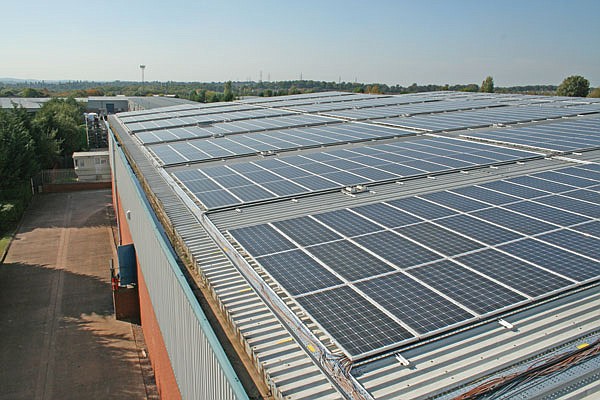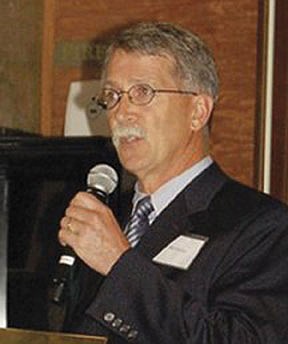 Facebook
Facebook
 X
X
 Instagram
Instagram
 TikTok
TikTok
 Youtube
Youtube

A pitched battle is raging on California rooftops. On one side are the state’s major electric utilities — San Diego Gas & Electric, Southern California Edison, and Pacific Gas & Electric. They have intimate friends on Wall Street and in Washington D.C., armies of lobbyists, and piles of cash to shovel at state politicians. The head of the California Public Utilities Commission is a former executive of Southern California Edison, as is the chairman of the assembly’s Committee on Utilities and Commerce.

On the other side of this war is inevitability — economic and scientific: rooftop solar power (along with other renewable energy sources, such as wind and hydro) will someday triumph.
To protect their profits and business model, and to keep their stock prices rising, utilities “are attempting to hold back a tsunami,” says Bill Powers of San Diego’s Powers Engineering. “Solar is coming. We have to transition from an insecure power supply — nuclear — and also from fossil fuel plants because of climate and greenhouse gas implications.”

Now, utilities depend on centralized facilities — particularly those using fossil fuels, such as coal and gas, or nuclear power. Reformers say these companies must go to a new model of “distributed,” or decentralized, generation — particularly rooftop solar. Because electric power plants account for 40 percent of carbon emissions, the Obama administration intends to tighten regulations on the plants.
“We are at a pivotal crossroads, where utilities have to look at a different business model that focuses more on distributed, small-scale resources, such as rooftop solar,” says Nicole Capretz of National City’s Environmental Health Coalition.

But the old business model is very profitable. Today, utilities make those profits by estimating how much they will have to spend on power plants, transmission lines, and the like; deciding how much they can get away with charging customers; and then going to the California Public Utilities Commission, claiming they need a certain rate of return to do their job. They usually get most of what they want. The more infrastructure they build, the fatter their profits. And that infrastructure generally worsens the environment.
Consider San Diego Gas & Electric. In late March, an administrative law judge of the California Public Utilities Commission decided that the utility deserved a fat rate hike — $6.55 a month for the typical electric consumer using 500 kilowatts per month. The commission will make the final decision. Consistently through the years, San Diego Gas has had the highest electric rates in the nation. The stock of its parent, Sempra Energy, has soared at double the rate of the overall market for a decade. But greed trumps the safety of future generations.
Fortunately, controversies about greenhouse gases and staggeringly high utility rates, among many things, have brought rooftop solar to the forefront, particularly in a metro area such as San Diego, which has abundant sunshine.
The utilities keep fighting. A study by the Edison Electric Institute, a trade association for the industry, complained of “disruptive challenges” such as distributed energy resources. Indeed, the institute, as well as utility executives, have wailed that the industry will be in a “death spiral” if rooftop solar takes hold significantly. Death spiral? Solar accounts for 2.5 to 3 percent of California’s electricity usage; California is the number-one solar state, although it’s only sixth on a per capita basis. Los Angeles County leads the state in rooftop generation and San Diego is second.
California has a net metering arrangement. At night, when you are drawing power, your utility bill rises. During the day, if the sun is shining and you have rooftop solar, the meter goes backward as you provide power to the grid. So that energy you provide is deducted from your bill.
Utilities complain that net metering costs them more than $1 billion a year and that it is unfair to customers who don’t have solar and have to subsidize those who do. “Utilities claiming they are looking out for ratepayers is like Bernie Madoff masquerading as the tooth fairy,” cracks Bryan Miller, vice president of public policy and power markets at San Francisco–based Sunrun Inc., a major residential solar provider.
Miller points to a study (admittedly financed by the solar industry) showing that net metering will soon deliver $92 million in annual benefits to all ratepayers. “Utilities don’t like rooftop solar purely because it eats into their profits,” says Miller. “[San Diego Gas & Electric] is only okay with solar when they own and profit from it.” By September, the California Public Utilities Commission is expected to come out with its study on the efficacy of the net metering system.
Under state regulations, on a hot summer afternoon no more than 5 percent of the electricity need can be met with customer-owned solar systems. Because of a recent encouraging change, the effective cap is now almost double 5 percent, says Powers. It’s not clear how the cap would be enforced, but that is a long way away, he says.
Now that San Onofre has closed, San Diego Gas & Electric claims there is a need for an old-style gas-powered plant in Otay Mesa, which was thumbed down by the commission in March. Balderdash, says Powers. There is power aplenty. “Due to the lack of effective regulatory oversight, giving the utilities everything they wanted for the last decade, we have overbuilt our supply generation and our transmission network,” he says. The utilities just want to boost profits.
Powers believes that in time, homes will go off the grid in large numbers. Indeed, he is in the process of doing that with his own home. He has eight batteries and needs eight more and a generator. Now, it will be slightly more expensive than using the conventional source, but with utility rates rising and solar costs declining, he can foresee a convergence — with some homeowners also maintaining their electric cars at home.
There are hopeful signs. Last year, San Diego Gas & Electric wanted to charge solar users substantially more for their connection to the distribution grid. The commission nixed the idea. On June 10, commissioner Carla Peterman proposed that the regulator begin a proceeding into whether utilities should adopt energy storage systems. This would enhance rooftop solar.
“The genie is out of the bottle, and it is not getting back in,” says Powers. “Yet utilities myopically forge ahead, insisting on obsolete investments.”


A pitched battle is raging on California rooftops. On one side are the state’s major electric utilities — San Diego Gas & Electric, Southern California Edison, and Pacific Gas & Electric. They have intimate friends on Wall Street and in Washington D.C., armies of lobbyists, and piles of cash to shovel at state politicians. The head of the California Public Utilities Commission is a former executive of Southern California Edison, as is the chairman of the assembly’s Committee on Utilities and Commerce.

On the other side of this war is inevitability — economic and scientific: rooftop solar power (along with other renewable energy sources, such as wind and hydro) will someday triumph.
To protect their profits and business model, and to keep their stock prices rising, utilities “are attempting to hold back a tsunami,” says Bill Powers of San Diego’s Powers Engineering. “Solar is coming. We have to transition from an insecure power supply — nuclear — and also from fossil fuel plants because of climate and greenhouse gas implications.”

Now, utilities depend on centralized facilities — particularly those using fossil fuels, such as coal and gas, or nuclear power. Reformers say these companies must go to a new model of “distributed,” or decentralized, generation — particularly rooftop solar. Because electric power plants account for 40 percent of carbon emissions, the Obama administration intends to tighten regulations on the plants.
“We are at a pivotal crossroads, where utilities have to look at a different business model that focuses more on distributed, small-scale resources, such as rooftop solar,” says Nicole Capretz of National City’s Environmental Health Coalition.

But the old business model is very profitable. Today, utilities make those profits by estimating how much they will have to spend on power plants, transmission lines, and the like; deciding how much they can get away with charging customers; and then going to the California Public Utilities Commission, claiming they need a certain rate of return to do their job. They usually get most of what they want. The more infrastructure they build, the fatter their profits. And that infrastructure generally worsens the environment.
Consider San Diego Gas & Electric. In late March, an administrative law judge of the California Public Utilities Commission decided that the utility deserved a fat rate hike — $6.55 a month for the typical electric consumer using 500 kilowatts per month. The commission will make the final decision. Consistently through the years, San Diego Gas has had the highest electric rates in the nation. The stock of its parent, Sempra Energy, has soared at double the rate of the overall market for a decade. But greed trumps the safety of future generations.
Fortunately, controversies about greenhouse gases and staggeringly high utility rates, among many things, have brought rooftop solar to the forefront, particularly in a metro area such as San Diego, which has abundant sunshine.
The utilities keep fighting. A study by the Edison Electric Institute, a trade association for the industry, complained of “disruptive challenges” such as distributed energy resources. Indeed, the institute, as well as utility executives, have wailed that the industry will be in a “death spiral” if rooftop solar takes hold significantly. Death spiral? Solar accounts for 2.5 to 3 percent of California’s electricity usage; California is the number-one solar state, although it’s only sixth on a per capita basis. Los Angeles County leads the state in rooftop generation and San Diego is second.
California has a net metering arrangement. At night, when you are drawing power, your utility bill rises. During the day, if the sun is shining and you have rooftop solar, the meter goes backward as you provide power to the grid. So that energy you provide is deducted from your bill.
Utilities complain that net metering costs them more than $1 billion a year and that it is unfair to customers who don’t have solar and have to subsidize those who do. “Utilities claiming they are looking out for ratepayers is like Bernie Madoff masquerading as the tooth fairy,” cracks Bryan Miller, vice president of public policy and power markets at San Francisco–based Sunrun Inc., a major residential solar provider.
Miller points to a study (admittedly financed by the solar industry) showing that net metering will soon deliver $92 million in annual benefits to all ratepayers. “Utilities don’t like rooftop solar purely because it eats into their profits,” says Miller. “[San Diego Gas & Electric] is only okay with solar when they own and profit from it.” By September, the California Public Utilities Commission is expected to come out with its study on the efficacy of the net metering system.
Under state regulations, on a hot summer afternoon no more than 5 percent of the electricity need can be met with customer-owned solar systems. Because of a recent encouraging change, the effective cap is now almost double 5 percent, says Powers. It’s not clear how the cap would be enforced, but that is a long way away, he says.
Now that San Onofre has closed, San Diego Gas & Electric claims there is a need for an old-style gas-powered plant in Otay Mesa, which was thumbed down by the commission in March. Balderdash, says Powers. There is power aplenty. “Due to the lack of effective regulatory oversight, giving the utilities everything they wanted for the last decade, we have overbuilt our supply generation and our transmission network,” he says. The utilities just want to boost profits.
Powers believes that in time, homes will go off the grid in large numbers. Indeed, he is in the process of doing that with his own home. He has eight batteries and needs eight more and a generator. Now, it will be slightly more expensive than using the conventional source, but with utility rates rising and solar costs declining, he can foresee a convergence — with some homeowners also maintaining their electric cars at home.
There are hopeful signs. Last year, San Diego Gas & Electric wanted to charge solar users substantially more for their connection to the distribution grid. The commission nixed the idea. On June 10, commissioner Carla Peterman proposed that the regulator begin a proceeding into whether utilities should adopt energy storage systems. This would enhance rooftop solar.
“The genie is out of the bottle, and it is not getting back in,” says Powers. “Yet utilities myopically forge ahead, insisting on obsolete investments.”
Comments